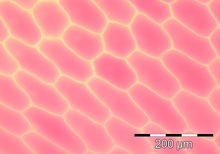Onion epidermal cell
This article needs additional citations for verification. (February 2009) |

The epidermal cells of onions provide a protective layer against viruses and fungi that may harm the sensitive tissues. Because of their simple structure and transparency, they are often used to introduce students to plant anatomy[1] or to demonstrate plasmolysis.[2] The clear epidermal cells exist in a single layer and do not contain chloroplasts, because the onion fruiting body (bulb) is used for storing energy, not photosynthesis.[3] Each plant cell has a cell wall, cell membrane, cytoplasm, nucleus, and a large vacuole. The nucleus is present at the periphery of the cytoplasm. The vacuole is prominent and present at the center of the cell, surrounded by cytoplasm.
Firm, small onions are best for microscopy. The epidermal layers are removed by cutting the onion and peeling them off (they are the membrane-like sheaths between each onion layer). For advanced microscopies, such as fluorescence microscopy, the layers halfway between the outside and the center of the onion are best.
References[edit]
- ^ "Plant anatomy at the University of Hamburg". Biologie.uni-hamburg.de. Archived from the original on 2013-01-22. Retrieved 2012-09-29.
- ^ Samworth, Mike. "Plasmolysis". Microscopy-uk.org.uk.
- ^ "Onion and Cheek Cells".
Plant cells are the fundamental units that makeup plants, ranging from the smallest moss to the tallest tree. They are eukaryotic cells, meaning that they contain a nucleus and other membrane-bound organelles. Plant cells are distinguished from animal cells by the presence of a cell wall, chloroplasts, and a large central vacuole. These components provide structural support and help plants perform photosynthesis, the process by which they convert sunlight into energy.
Photosynthesis is the primary function performed by plant cells. It occurs in the chloroplasts, which are tiny organelles found within the cytoplasm of plant cells. Chloroplasts contain the pigment chlorophyll, which absorbs light energy from the sun and converts it into chemical energy that the plant can use. During photosynthesis, carbon dioxide is taken in from the air and combined with water to produce glucose, a type of sugar that serves as an energy source for the plant.
The cell wall is another defining feature of plant cells. It is a rigid structure that surrounds the cell membrane and provides support and protection for the cell. The cell wall is made up of cellulose, a complex carbohydrate that also plays a role in photosynthesis. In addition to cellulose, the cell wall contains other polysaccharides and proteins that help give it strength and flexibility.
Another unique feature of plant cells is the large central vacuole. This organelle is filled with water and plays a role in maintaining the turgor pressure of the cell, which helps the plant maintain its shape. The central vacuole also serves as a storage compartment for nutrients and waste products and can help regulate the pH and ion balance of the cell.
Overall, plant cells' structure and function are critical to plant survival and growth. By performing photosynthesis, producing structural support, and regulating cellular processes, plant cells enable plants to thrive in a wide range of environments, from deserts to rainforests. Understanding the biology of plant cells is therefore essential for improving agriculture, developing new medicines, and protecting our planet's ecosystem.
1. Plant cells are the basic units of plants and perform photosynthesis, the process of preparing food using sunlight, carbon dioxide, and water.
2. Photosynthesis occurs in the chloroplasts of plant cells.
3. Botany is the science of plant life and a branch of biology.
4. A botanist specializes in the study of plants and may concentrate on specific types of plants.
5. The different fields of botany include morphology, physiology, ecology, and systematics.
6. Plant pathology is the study of organisms and environmental conditions that cause diseases in plants, the mechanisms by which the disease occurs, and the methods of controlling plant diseases.
7. Plant ecology is concerned with the relationships between plants and their environment, including the study of ecosystems.
8. Paleobotany is the study of ancient plants, including their morphology and evolution.
9. Archaeobotany is the study of plants in relation to archaeological sites and historical events.
10. Forensic botany applies botanical knowledge to legal and criminal investigations.
11. In botany and mycology, division is a rank equivalent to phylum.
12. These different fields and areas of study within botany contribute to our understanding of the plant kingdom and how plants interact with their environment.
